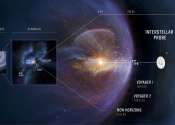Milky Way's origins are not what they seem
In a first-of-its-kind analysis, Northwestern University astrophysicists have discovered that, contrary to previously standard lore, up to half of the matter in our Milky Way galaxy may come from distant galaxies. As a result, ...









